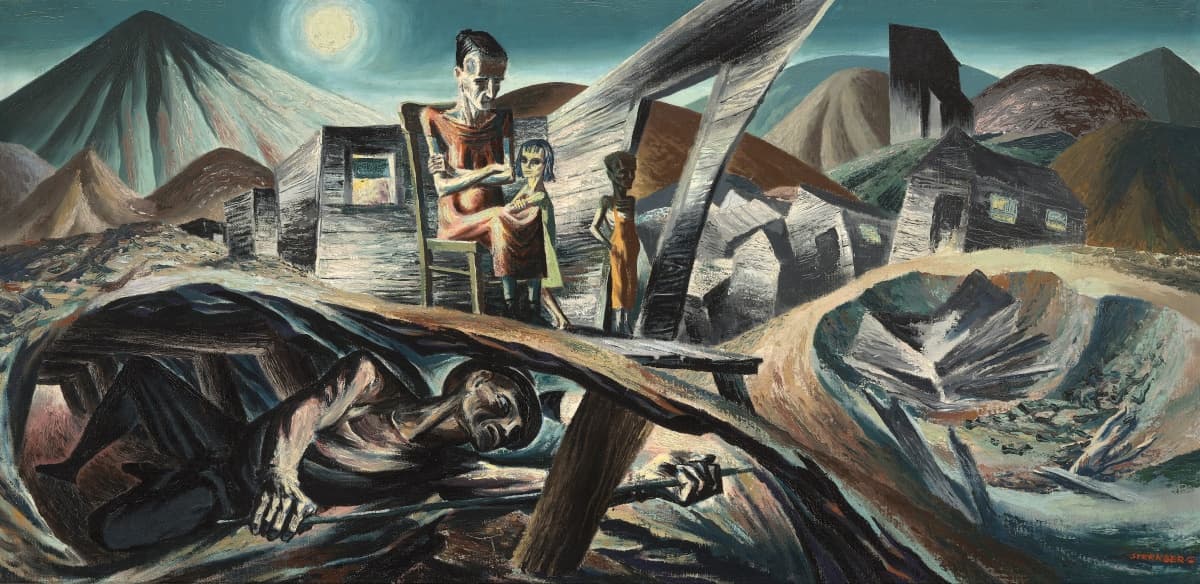Art for the People: WPA-Era paintings from the Dijkstra Collection

The Crocker Art Museum is pleased to announce the exhibition Art for the People: WPA Era Paintings from the Dijkstra Collection, on view at the Museum January 29 – May 7, 2023. Drawn from the Collection of Sandra and Bram Dijkstra, Art for the People focuses on representational painting created in the years between the American stock market crash of 1929 and World War II. During this era, which led to, and included, the government-sponsored WPA (Works Progress Administration) of the 1930s and early 1940s, many American artists created scenes that represented the country and its people and sought to produce art that expressed fundamental human concerns and basic democratic principles.
This more encompassing look at WPA-era art features paintings from the East, Midwest, and West, with a strong representation of work by Californians, who have often been omitted from the narrative. Names for the art of this period have ranged from Regionalism and American Scene Painting to Social Realism and American Expressionism. Regardless of the label, what these works had in common was each artist’s desire to make their work accessible (and hence meaningful) to the general public. In creating a “people’s art,” these artists used familiar themes, easily readable stories, and, occasionally, nostalgia to make their points, and much imagery of the period focused on the people themselves—especially laborers, the poor, and the disenfranchised—along with their activities, their rural and urban environments, contemporary modes of transportation, and other subjects close at hand. Their cause was advanced by federally funded arts projects that also championed these goals and, at the same time, effectively made artists “workers” themselves. By extension, the artists became visual spokespeople for other types of laborers trying to survive during such difficult times.
The exhibition begins with examples of art from the 1920s, as a modernist visual language of protest emerged, and concludes with paintings from the war years, when the focus on representation came to be subverted—and denigrated—by means of an equally politically motivated visual language that sought to privilege abstraction over recognizable content. Art for the People aims to encourage viewers to see works from this period in a more expansive way and to celebrate artists from varied backgrounds and locales, with diverse worldviews and artistic goals, who have often been overlooked. The exhibition seeks also to position these artists’ work through an historical lens (rather than the cynical, and often anti-representational, modernist eye of the postwar era) and, by doing so, celebrate not just the artists’ aesthetic accomplishments but the humanity of their intentions.
In the Midwest, these paintings often documented rapidly passing ways of life and the changing landscape. Often anti-urban, anti-modern, and escapist, some of the imagery ignored the effects of the Depression and the Dust Bowl, indulging instead in a nostalgia for earlier, better times. And yet, painters broadly designated as Regionalists also participated in an “anti–American Gothic” sentiment as well.
Artists of the East Coast, by contrast, most often called “Social Realists” or, sometimes, “Urban Expressionists,” documented a different experience, one more deeply committed to principles of social justice. Distrustful of the nationalism promoted by the Regionalists, they made art that was deeply humanist and featured the plight of the poor and persecuted in the hope of creating change.
In the West, many of the WPA-era artists were based in California. Here, the beauty of the landscape, which had long inspired transcendental ideals, mitigated the pessimism felt by their East Coast colleagues, though even in this environment artists sought subjects that departed from the previous generation’s idyllic representation of the land. Their work ranged from country farms set amid rolling green hills, to beachgoers on holiday, to socially critical scenes of downtrodden workers in the city. Like their colleagues in other regions, their focus was anything but unified, evidencing regional differences in terms of subject matter and politics that, when looked at broadly, provide us with a greater understanding of what constituted American art at this pivotal time.
Art for the People is accompanied by a fully illustrated hardcover catalogue with essays by Susan M. Anderson, Henry Adams, and Scott A. Shields. The exhibition was organized by the Crocker Art Museum, the Oceanside Museum of Art, and The Huntington Library, Art Museum, and Botanical Gardens. The show, which will be presented differently at each of these California venues, will be on view at the Crocker in Sacramento from January 29 to May 7, 2023; at Oceanside from June 24 to November 5, 2023; and at The Huntington in San Marino from December 2, 2023 to March 18, 2024.
The Museum brings the exhibition to life with a variety of public programs and studio classes.
EXHIBITION RELATED EVENTS AND PROGRAMS
Public Programs
Curator in Conversation: Art in Times of Crisis – Saturday, February 4
The Official Rogue Book Club: The Muralist: A Novel by Barbara Shapiro – Thursday, March 2
ArtMix: MOVEments – Thursday, March 9
Studio Classes:
Art Boot Camp: Portraiture – Tuesdays and Thursdays, February 7-23
How to Paint Skin Tone – Tuesdays, February 28 and March 7
Senior Studio: Introduction to Drawing – Wednesdays and Thursdays, March 8-16